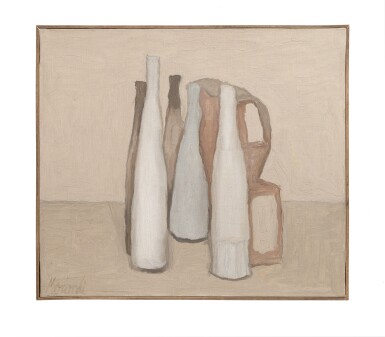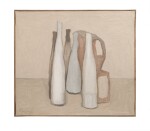
PROPERTY FROM AN IMPORTANT TUSCAN COLLECTION
GIORGIO MORANDI | NATURA MORTA
Lot Closed
June 16, 02:30 PM GMT
Estimate
750,000 - 1,000,000 EUR
Lot Details
Description
PROPERTY FROM AN IMPORTANT TUSCAN COLLECTION
GIORGIO MORANDI
1890 - 1964
NATURA MORTA
signed
oil on canvas
Executed in 1951
(firmato
olio su tela
Eseguito nel 1951)
cm 37.8x43,1x2,4; inches 14.88 by 16.53 by 16.96 by 0.94
Framed (con cornice): cm 64.6x69.8x5.7; inches 25.43 by 27.48 by 2.24
To view shipping calculator, please click here
Galleria del Milione, Milan
Riccardo and Magda Jucker Collection, Milan
Galleria Marescalchi, Bologna
Vito Toffano Collection, Padua
Galleria Farsetti, Florence
Acquired from the above by the family of the present owner in the early 2000s
Berna, Kunsthalle, Giorgio Morandi, 1965, n. 82, illustrated
Rome, Galleria Nazionale d'Arte Moderna, Giorgio Morandi (1890-1964), 1973, pp. 117, 120, n. 83, illustrated in colour
Focette; Cortina d'Ampezzo; Milan, Galleria d'Arte Moderna Farsetti, 'A Prato per vedere Corot', Corrispondenza Morandi-Soffici per un'antologia di Morandi, 1989, n. XX, illustrated in colour
Firenze, Galleria d'Arte Frediano Farsetti, Giorgio Morandi. Pittore di luce e di silenzio, 2011, pp. 104-105, n. 32, illustrated in colour
Lamberto Vitali, Giorgio Morandi pittore, Milan, editions 1964-1965 and 1970, n. 197, illustrated
Lamberto Vitali, Morandi. Catalogo generale, volume secondo 1948/1964, Milan 1977, n. 784, illustrated
Giorgio Morandi is an artist who, in that short time span dotted with wars, revolutions and radical changes that was the Twentieth Century, emerges and stands out for his compositional harmonies that speak of a time suspended between dream and reality, between the quotidian realism of substance and the deeper meaning of human existence.
His silent and iconic compositions of bottles and objects are immersed in a reduced but intense chromatic palette, among which browns, whites and rare brighter colours emerge, like sparks in the theatre of everyday life. His works are situated at the apex of all European art, with attention paid to the work of Chardin and Cézanne. Morandi admired the latter’s "gigantic effort to synthesise volume and brightness, the result of which it was a work which began a pictorial renaissance and put future generations on the path of true, eternal classicism by bringing together the benefits of new research and that drawn from the teachings of the past" (Letter from Morandi to Ardengo Soffici). Yet these two masters maintain their independent identity, often exceeding in intensity even the great painters of the past. Wrapped in a timeless aura, at a remove from the wear and tear of time and history, they appear eternal in their simplicity, regulated by a style that, in its constant variations, redefines itself from time to time in a new light. The light that is idiosyncratic to Morandi is a living and active presence, capable of eternally illuminating the humblest objects in the barest room.
Natura Morta from 1951 is part of a group of four works from the same year that show minimal variations around the same composition, one of which is preserved in the Tel Aviv Museum of Art (a similar but later version from 1957 is preserved in Fondazione Carraro at Ca’ Pesaro): this version is characterised by a delicate shade of pastel blue that joins on the usual palette dominated by greys and browns. This weightless, ethereal and uncommon colour in Morandi's production, expertly placed on the bottle in the centre, seems to open a metaphorical window on the world outside the room and the objects represented. The work fits into the context of the 1950s, which was an important decade for Morandi's career. He had recently had great success in the United States, including exhibitions in important museum institutions, such as the 1949 show at the Museum of Modern Art in New York, organised by Alfred Barr and James Thrall Soby, and articles published by famous art magazines. Despite his undeniable fame and success, the Bolognese artist remained always faithful to his shy, meditative and almost philosophical nature, not giving in to the temptations of his well-deserved world-wide fame but rather devoting himself even more forcefully to his work, retreating into the quiet of his studio and his paintings.
In Natura Morta of 1951 we find all the main themes of Morandi's oeuvre, indeed the composition of objects reveals the deep meditations of the Bolognese artist on the multifaceted aspects of human existence in connection with the divine harmony of creation. It is a celebration of the interior, physical space that reflects the interiority of the soul, in which every apparent, minimal change can produce a brand new and unexpected effect. All the while outside his studio the great artistic upheavals of the informal and abstract art were taking place between the wars and the decade following World War Two. Yet Morandi, never involved himself, remaining ever faithful to his aesthetic. For him, the world and all the essence of life and its mystery have but a simple room as their theatre.
Giorgio Morandi è un artista che, in quel secolo breve costellato da guerre, rivoluzioni e cambiamenti radicali che fu il 900, emerge e si staglia per un’armonia compositiva che racconta di un tempo sospeso tra sogno e realtà, tra il realismo quotidiano della materia e il senso più profondo dell’esistenza umana. Le sue silenti e iconiche composizioni di bottiglie e oggetti si presentano immerse in una tavolozza cromatica ridotta ma di grande intensità, tra cui emergono i bruni, i bianchi e rari colori più accesi, come scintille nel teatro del quotidiano: le sue opere si pongono all’apice di un percorso che attraversa tutta l’arte europea, con un’attenzione particolare all’opera di Chardin e soprattutto di Cézanne di cui Morandi ammirava “lo sforzo gigantesco di sintetizzare in tutto il senso del volume e della luminosità, il cui risultato è stato un’opera la quale, riunendo in sé il buono delle nuove ricerche e quello tratto dagli insegnamenti del passato, inizia una rinascenza pittorica, e metterà le generazioni future sulla strada di un classicismo vero, eterno” (da una lettera di Morandi ad Ardengo Soffici) ma mantengono sempre una loro identità totalmente indipendente, spesso superando in intensità anche i grandi maestri del passato. Avvolte da un’aura atemporale, sottratte al logorio del tempo e della storia, appaiono eterne nella loro semplicità, regolate da un modulo che, nelle sue costanti variazioni, si mostra di volta in volta sotto una luce nuova, proprio quella luce, così tipica di Morandi, che è essa stessa presenza viva e attiva, capace di illuminare d’eternità i più umili oggetti e la più spoglia stanza.
Natura Morta del 1951 fa parte di un gruppo di quattro opere del medesimo anno che presentano minime variazioni intorno alla stessa composizione, di cui una è conservata al Tel Aviv Museum of Art (una composizione simile ma più tarda, del 1957, è conservata alla Fondazione Carraro a Ca’ Pesaro): questa versione è caratterizzata dalla delicata tonalità pastello dell’azzurro che si inserisce sulla consueta tavolozza dominata dai grigi e dai bruni. Un colore leggero, etereo e non comune nella produzione di Morandi, che, apposto sapientemente sulla bottiglia al centro, sembra aprire una metaforica finestra sul mondo al di fuori della stanza e degli oggetti rappresentati. L’opera si inserisce nel contesto degli anni ’50, che furono un momento importante per la carriera di Morandi: negli Stati Uniti aveva recentemente riscosso grande successo, tra mostre in importanti istituzioni museali – come quella del 1949 al Museum of Modern Art di New York, organizzata da Alfred Barr e James Thrall Soby – e articoli pubblicati da celebri riviste di settore. Nonostante l’innegabile fama e successo, l’artista bolognese rimase però sempre fedele alla sua natura schiva, meditativa e quasi filosofica, non concedendosi alle tentazioni di una fama ormai mondiale e certamente meritata, ma si dedicò con ancora più forza al suo lavoro, ritirandosi nella quietà del suo studio e della sua arte.
In Natura Morta del 1951 sono riscontrabili i principali temi presenti nelle opere di Morandi e l’opera rivela, dietro all’espediente della composizione di oggetti, le profonde meditazioni dell’artista bolognese sui multiformi aspetti dell’esistenza umana, in connessione con la divina armonia del creato. È la celebrazione dell’”interno”, spazio fisico che appare in realtà per la sua vera natura, quella dell’interiorità dell’animo, in cui ogni apparente, minimo cambiamento può produrre un effetto totalmente nuovo e imprevisto. Tutto questo mentre “al di fuori”, tra gli anni della guerra e il decennio successivo, si consumano i nuovi, grandi rinnovamenti artistici dell’Informale e dell’astrattismo, da cui però Morandi, sempre fedele a sè stesso, non si fece mai coinvolgere: per lui, il mondo e tutta l’essenza stessa della vita e del suo mistero hanno come teatro una semplice stanza.
